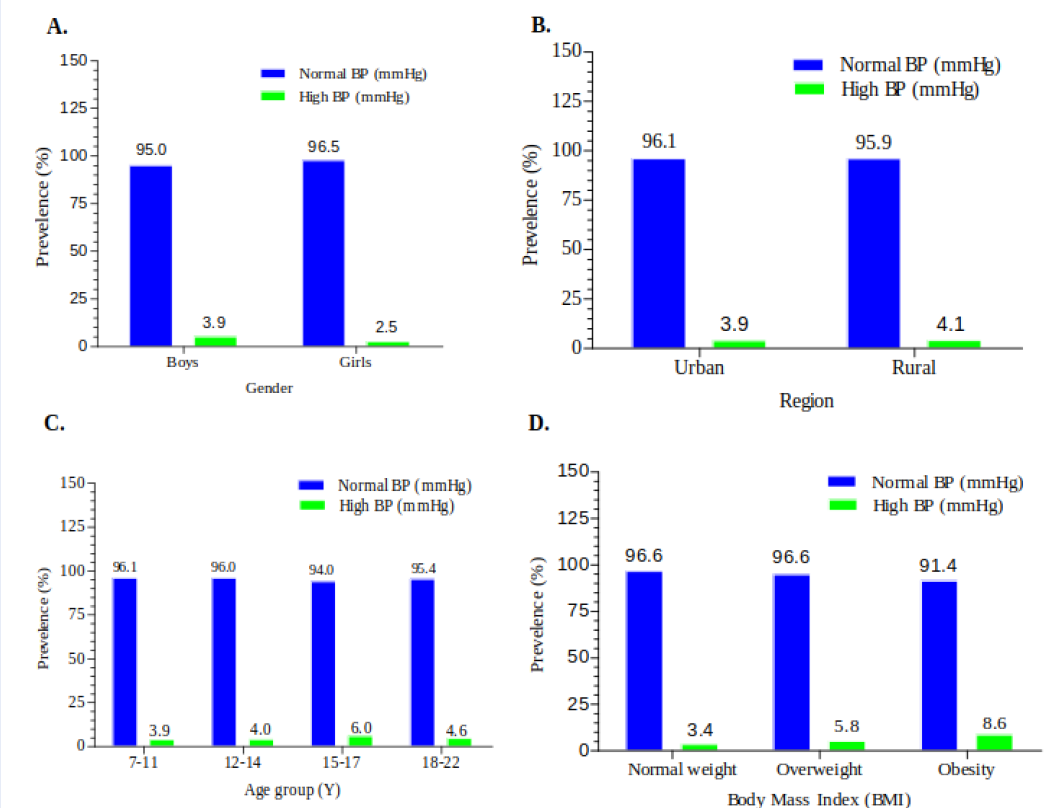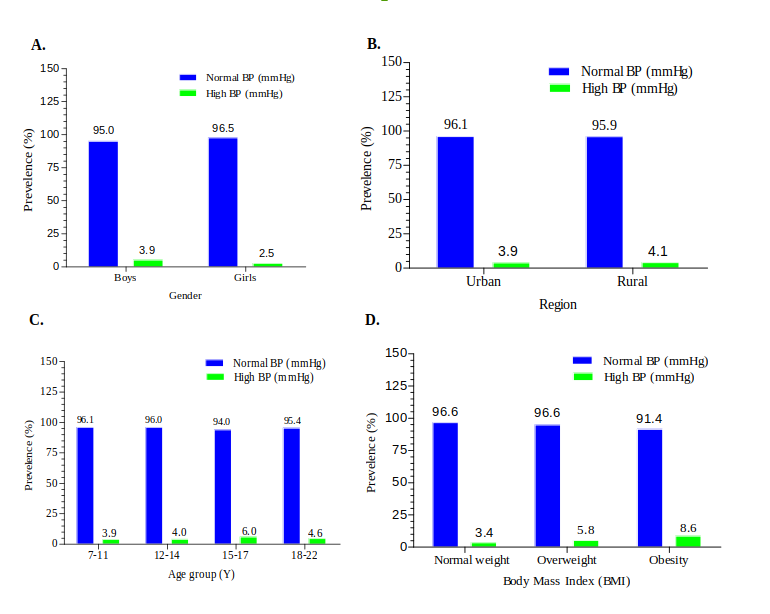Abstract
Aim: Obesity and Blood Pressure (BP) is a serious public health issue. The study aims to assess the prevalence of BP and the factors associated with High Blood Pressure (HBP) among student in Jiangsu Province, China.
Methods: A cross-sectional epidemiological study. A total of 101886 students (62,065 boys and 39,821 girls) aged range from 7-22 yea rs were recruited in 2010-2013. Anthropometric measurements and BP prevalence were measured, and in addition, body mass index (BMI) was calculated. We assess the prevalence of BP according to the National Blood Pressure Reference for Chinese Han children and adolescents.
Results: A significant difference was observed in HBP prevalence in terms of student gender, region, age and BMI (P<0,001). Overweight and obesity were significantly associated with HBP (P<0.001).
Conclusions: The findings convey an important message to the parents, health institutions that urgent action is needed to enhance effective control of HBP among the overweight and obese, and among those are living in a rural area.
Introduction
Obesity is a global health problem1. The prevalence was significantly increased in all countries1,2,3. Approximately 2.8 million people were dying each year because of overweight4. Body Mass Index (BMI) was commonly used for screening overweight and obese in clinical practice and population survey5. High blood pressure (hypertension) was significantly increased among Chinese recently6. Obesity is a risk factor for diabetes, stroke, cardiovascular diseases and their complications6,7. Ten million persons in the world die annually with BP6. Childhood BP is a significant predictor of adulthood BP8. Development of socio-economic in China results in massively increased health issues2,3,6.
The trend of BP prevalence was reported among Chinese children and adolescents3,6,9,10,11,12,13,14. However, little is known about their association with gender, age, region and BMI level among student in Jiangsu Province. The province, is located in eastern-central coastal of China, covered 102,600 km2 and total population 80,400,000 in 2018 (https://en.wikipedia.org/wiki/Jiangsu). The data was obtained from the Students Physical Fitness and Health Surveys (SPFHS), conducted from 2010 to 2013. The aim was to assess the prevalence of HBP and NBP among students.
| Variables | S.E. | P-value | OR (95.0% C.I.) |
|---|---|---|---|
| Gender (Male/Female) | 0.05 | 0.001 | 0.77 (0.69-0.85) |
| Region (Urban/Rural) | 0.05 | 0.001 | 1.19 (1.09-1.31) |
| Age in years (7-11) | 0.001 | Reference | |
| 12-14 | 0.07 | 0.001 | 2.21 (1.91-2.56) |
| 15-17 | 0.07 | 0.001 | 2.42 (2.09-2.80) |
| 18-22 | 5.40 | 0.001 | 0.83 (0.77-0.90) |
| BMI (Normal weight) | 0.001 | Reference | |
| Overweight | 0.06 | 0.001 | 1.27 (1.12-1.44) |
| Obesity | 0.06 | 0.001 | 2.44 (2.15-2.75) |
| Constant | 0.13 | 0.001 | 0.017 |
Methods
A cross-sectional study was carried out during September 2010 to September 2013. The study subjects includes male and female students aged 7-22 years enrolled in Students Physical Fitness and Health Surveys (SPFHS). The study population were randomly selected from 10 universities and 82 schools in Jiangsu Province, resulting in an estimated sample of, 101,886 students (62,065 boys and 39,821 girls). Data were collected by trained health staff and physician from Jiangsu Center for Disease Prevention and Control (CDC) health team.
Students BP was assessed using a portable digital monitors Omron HEM 705 CP (OMRON, Kyoto, Japan), and blood pressure was measured on the right arm twice, in the morning and, no less than 30 minutes after breakfast, when children had empty bladders, after at least 5 minutes of rest, sitting, with back support and feet on the ground, without moving or talking12.
Normal Blood Pressure (NBP) was defined as anyone with Systolic Blood Pressure 120 -129 (mmHg), and Diastolic Blood Pressure is <80 (mmHg). High Normal Blood Pressure for anyone with Systolic Blood Pressure 130-139 (mmHg) or Diastolic Blood Pressure is 80-89 (mmHg). The average value of three BP readings was recorded. HBP and NBP prevalence were evaluated using new CCBP reference13, and update of the age and gender-specific BP cutoffs for Chinese children and adolescents reference15. Student body Mass Index (BMI)2 was calculated from height and weight. BMI cut-off recommended by Working Group on Obesity in China16. The study protocol was approved by the Institutional review board of School of public health Southeast University, Nanjing. A written informed consent was obtained from each participant’s parent for those in primary school. A total of 101,886 students were agreed to complete anthropometric measurement. All analyses were performed using SPSS version 25.0 for Windows (IBM SPSS, Chicago, IL, USA).
Results and Discussion
There was a significant difference in the prevalence of BP between gender, region, age groups and BMI categories, respectively (P<0.001). BMI level had a higher BP among overweight and obese groups (Figure 1). BP was significantly (P<0.001) associated with the rural area, age 12-14, age 15-17, and BMI level, including overweight, and obese group (Table 1)
The study confirmed that obesity could lead to serious health problems,2,7,8 there was a significant difference in BP prevalence within the overweight and obese groups compared with the normal weight15 and the finding is line with previous studies2,3,7. Age, region and BMI level were significantly associated with the risk of HBP, similar to study reported in China6.
In conclusions, the prevalence of BP was recorded high in females as compared to males. Results suggest that high BP is attributed mainly to a residential area (urban vs. rural), age groups and BMI level (Overweight and obese). Nevertheless, the risk of overweight and obesity are considered the significant risk factor associated with BP rate. In a public health point of view, early action is needed to reduce blood pressure and to control the factors related to high BP towards student health in the future.
Abbreviations
BP: Blood Pressure
BMI: Body Mass Index
HBP: High Blood Pressure
NBP: Normal Blood Pressure
SPFHS: Students Physical Fitness and Health Surveys
Authors' Contributions
Idea and study designed: THM
Funding
The study was funded by Jiangsu Provincial Social Science Foundation, grant number 13TYA001.
Acknowledgement
The authors thank P.W and the staff of Jiangsu Health Literacy Promotion and Research Office for providing access to the student health data for analysis.
References
-
Wang
Y,
Lobstein
T I,
Worldwide trends in childhood overweight and obesity. International Journal of Pediatric Obesity.
2006;
1
(1)
:
11-25
.
View Article Google Scholar -
Musa
Taha Hussein,
Li
WEI,
LI
Xiao Shan,
PU
Yue Pu,
Wei
Ping Min,
Prevalence of Overweight and Obesity among Students Aged 7-22 Years in Jiangsu Province, China. Biomedical and Environmental Sciences.
2016;
29
(10)
:
697-705
.
View Article Google Scholar -
Sun
H,
Ma
Y,
Han
D,
Pan
C W,
Xu
Y,
Prevalence and trends in obesity among Chinas children and adolescents. PloS One.
2014;
9
(8)
:
1985-2010
.
View Article Google Scholar -
Cole
T J,
Bellizzi
M C,
Flegal
K M,
Dietz
W H,
Establishing a standard definition for child overweight and obesity worldwide: international survey. The BMJ.
2000;
320
(7244)
:
1240-1240
.
View Article Google Scholar -
World Health Organization. 10 facts on obesity.
.
-
Dong
B,
Wang
H J,
Wang
Z,
Liu
J S,
Ma
J,
Trends in blood pressure and body mass index among Chinese children and adolescents from 2005 to 2010. American Journal of Hypertension.
2013;
26
(8)
:
997-1004
.
View Article Google Scholar -
Boyd
G S,
Koenigsberg
J,
Falkner
B,
Gidding
S,
Hassink
S,
Effect of obesity and high blood pressure on plasma lipid levels in children and adolescents. Pediatrics.
2005;
116
(2)
:
442-6
.
View Article Google Scholar -
Chen
X,
Wang
Y,
Tracking of blood pressure from childhood to adulthood: a systematic review and meta-regression analysis. Circulation.
2008;
117
(25)
:
3171-3171
.
View Article Google Scholar -
Ma
J,
Wang
Z,
Dong
B,
Song
Y,
Hu
P,
Zhang
B,
Quantifying the relationships of blood pressure with weight, height and body mass index in Chinese children and adolescents. Journal of Paediatrics and Child Health.
2012;
48
(5)
:
413-421
.
View Article Google Scholar -
Dong
B,
Wang
Z,
Wang
H J,
Ma
J,
Associations between adiposity indicators and elevated blood pressure among Chinese children and adolescents. Journal of Human Hypertension.
2015;
29
(4)
:
236
.
View Article Google Scholar -
Zhang
Y X,
Zhao
J S,
Sun
G Z,
Lin
M,
Chu
Z H,
Prevalent trends in relatively high blood pressure among children and adolescents in Shandong. China. Annals of Human Biology.
2012;
39
(3)
:
259-63
.
View Article Google Scholar -
Chen
Z,
Wang
X,
Wang
Z,
Zhang
L,
Hao
G,
Dong
Y,
Zhu
M,
Gao
R,
Group
C H,
Assessing the validity of oscillometric device for blood pressure measurement in a large population-based epidemiologic study. Journal of the American Society of Hypertension.
2017;
11
(11)
:
730-736
.
View Article Google Scholar -
Dong
Y,
Ma
J,
Song
Y,
Dong
B,
Wang
Z,
Yang
Z,
Wang
X,
Prochaska
J J,
National Blood Pressure Reference for Chinese Han children and adolescents aged 7 to 17 years. Hypertension.
2017;
70
(5)
:
897-906
.
View Article Google Scholar -
Mi
J,
Wang
T Y,
Meng
L H,
Zhu
G J,
Han
S M,
Zhong
Y,
Liu
G M,
Wan
Y P,
Xiong
F,
Shi
J P,
Yan
W L,
Development of blood pressure reference standards for Chinese children and adolescents. Chinese Journal of Evidence Based Pediatrics.
2010;
5
(1)
:
4-14
.
-
Wang
S R,
Zhu
Y B,
Cheng
Y,
Zhang
Y X,
Profiles of blood pressure among children and adolescents with different body mass index categories in Shandong, China. Blood Pressure.
2018;
27
(1)
:
56-61
.
View Article Google Scholar -
CY
Ji,
Cooperative Study on Childhood Obesity, Working Group on Obesity in China (WGOC). Report on Childhood Obesity in China (1): Body Mass Index Reference for Screening Overweight and Obesity in Chinese School-age Children. Biomedical and Environmental Sciences.
2005;
18
:
390-400
.
Comments

Downloads
Article Details
Volume & Issue : Vol 6 No 8 (2019)
Page No.: 3333-3335
Published on: 2019-08-28
Citations
Copyrights & License

This work is licensed under a Creative Commons Attribution 4.0 International License.
Search Panel
Pubmed
Google Scholar
Pubmed
Google Scholar
Pubmed
Google Scholar
Pubmed
Google Scholar
Pubmed
Google Scholar
Pubmed
Search for this article in:
Google Scholar
Researchgate
- HTML viewed - 4028 times
- Download PDF downloaded - 1159 times
- View Article downloaded - 0 times
 Biomedpress
Biomedpress


